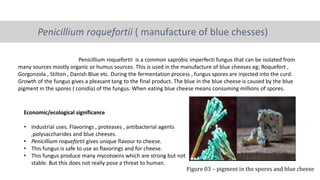The document provides an overview of the phylum Deuteromycota, highlighting its characteristics as a group of asexual fungi known as 'imperfect fungi' due to the absence of observed sexual reproduction. It discusses the economic importance of various members, including their roles in causing diseases like athlete's foot, producing antibiotics like penicillin, and affecting agriculture through plant pathogens. Additionally, it notes the potential for using certain fungi in biological control of crop pests and soil-borne diseases.

















